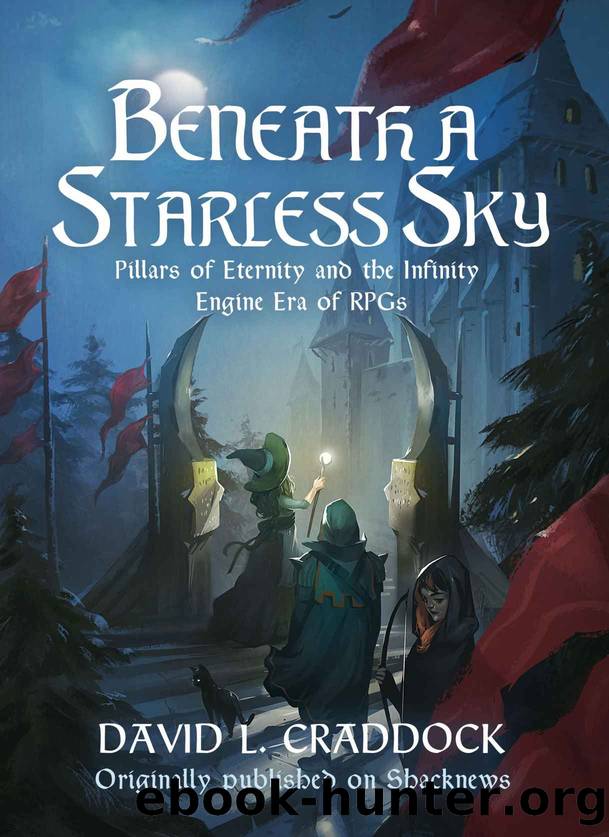Beneath a Starless Sky: Pillars of Eternity and the Infinity Engine Era of RPGs (Shacknews Long Reads Book 2) by David L. Craddock

Author:David L. Craddock
Language: eng
Format: mobi
Publisher: Shacknews
Published: 2019-07-26T07:00:00+00:00
CHAPTER 6: BUILDING A DIORAMA
LIKE A FAMILY recipe passed down through generations, crafting an environment in a roleplaying game calls for specific ingredients. The quantities of those ingredients varies depending on the flavor of RPG one aspires to make.
Over the spring and summer of 2013, Pillars of Eternityâs developers baked their Infinity Engine RPG cake and cut off a vertical slice. âThat was the June to August timeframe when we were trying to finish that up,â Adam Brennecke explained. âThe vertical slice was the Dyrford Village scene. We wanted all the core elements of the game working and up and running at that stage, before moving into production.â
Vertical slice is industry speak for a playable chunk of a game designed to showcase progress across an entire project. The concept artwork and animated background Obsidian had released in late 2012 and the spring of 2013, respectively, formed its foundation, the pan in which the rest of the game would be prepared. The goal of a vertical slice is to incorporate most or all of the features to be used in the final version of a game. Once the slice is finished, content creators build out from there.
More developers piled onto teams as work on South Park: The Stick of Truth wound down. Bobby Null, designated lead level designer, was one of the most excited to dig into Pillars of Eternity. Though he had joined Obsidian five years earlier, contributing to design for Neverwinter Night 2 expansions as well as Dungeon Siege III and South Park, his penchant for building dated back to childhood.
âEver since I was a little kid, I've loved Legos, erector sets, Lincoln Logs,â Null said. âBuilding things is cool, and I think level designers, most of the ones I know, have that same mentality. They just love to put things together. For me, inherently, area design is the most interesting of the design disciplines from the sense that you're touching everything. You're responsible for the final level. You're taking everybody's work, all these creative people's workâincluding your ownâand putting it all together in a finished piece.â
Dyrford Village was the first area created for Pillars of Eternity by being the area built for the vertical slice. That single area spanned eleven maps to provide a sampling of each major type of environment: towns, dungeons, and wilderness. Every disciplineâs leaders had priorities. As Art Director, Rob Nesler focused on concerns such as environmental details that transformed spaces from oddly shaped containers to hold characters and gameplay, into towns, forests, and dungeons that felt alive. âIf we're building a world where human beings are characters, I feel it's important that we assemble things in a way that looks like human beings would build them and live in them,â he explained of Dyrford. âThat was one of my main rules.â
A dirt road leads into Dyrford Village from the northeast and wends south, broadening into a town square that hosts an innâthe villageâs largest buildingâa mill, a few houses and shops, and a temple.
Download
This site does not store any files on its server. We only index and link to content provided by other sites. Please contact the content providers to delete copyright contents if any and email us, we'll remove relevant links or contents immediately.
Exploring Deepfakes by Bryan Lyon and Matt Tora(8153)
Robo-Advisor with Python by Aki Ranin(8103)
Offensive Shellcode from Scratch by Rishalin Pillay(6322)
Microsoft 365 and SharePoint Online Cookbook by Gaurav Mahajan Sudeep Ghatak Nate Chamberlain Scott Brewster(5487)
Ego Is the Enemy by Ryan Holiday(5263)
Management Strategies for the Cloud Revolution: How Cloud Computing Is Transforming Business and Why You Can't Afford to Be Left Behind by Charles Babcock(4508)
Python for ArcGIS Pro by Silas Toms Bill Parker(4391)
Elevating React Web Development with Gatsby by Samuel Larsen-Disney(4116)
Machine Learning at Scale with H2O by Gregory Keys | David Whiting(4094)
Liar's Poker by Michael Lewis(3350)
Learning C# by Developing Games with Unity 2021 by Harrison Ferrone(3322)
Speed Up Your Python with Rust by Maxwell Flitton(3264)
OPNsense Beginner to Professional by Julio Cesar Bueno de Camargo(3237)
Extreme DAX by Michiel Rozema & Henk Vlootman(3222)
Agile Security Operations by Hinne Hettema(3151)
Linux Command Line and Shell Scripting Techniques by Vedran Dakic and Jasmin Redzepagic(3139)
Essential Cryptography for JavaScript Developers by Alessandro Segala(3108)
Cryptography Algorithms by Massimo Bertaccini(3045)
AI-Powered Commerce by Andy Pandharikar & Frederik Bussler(3013)
